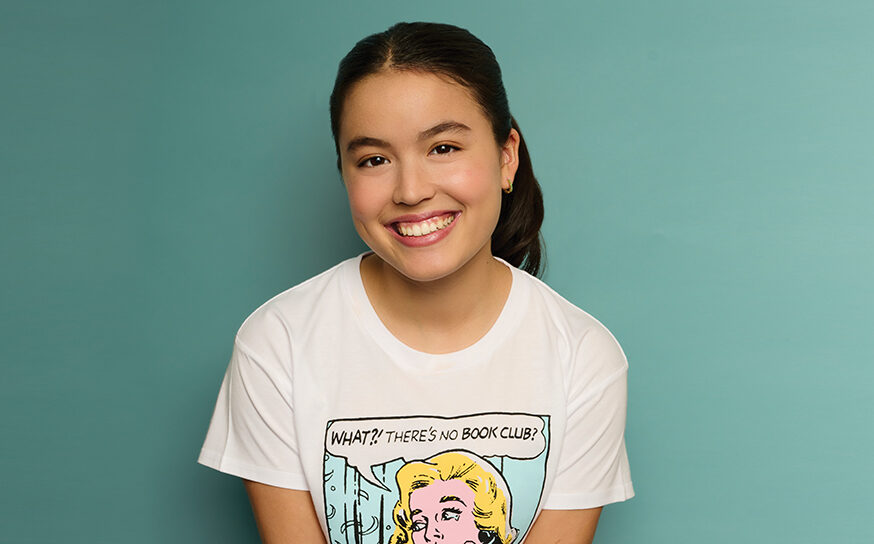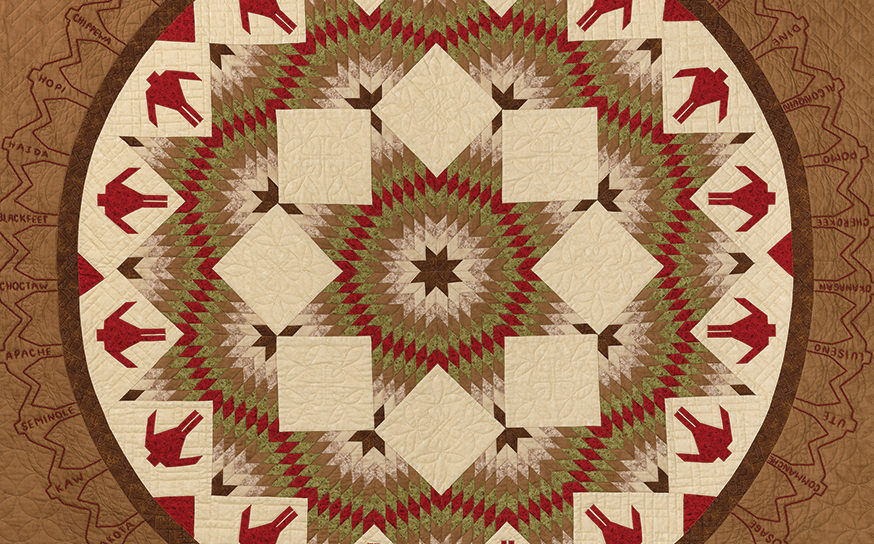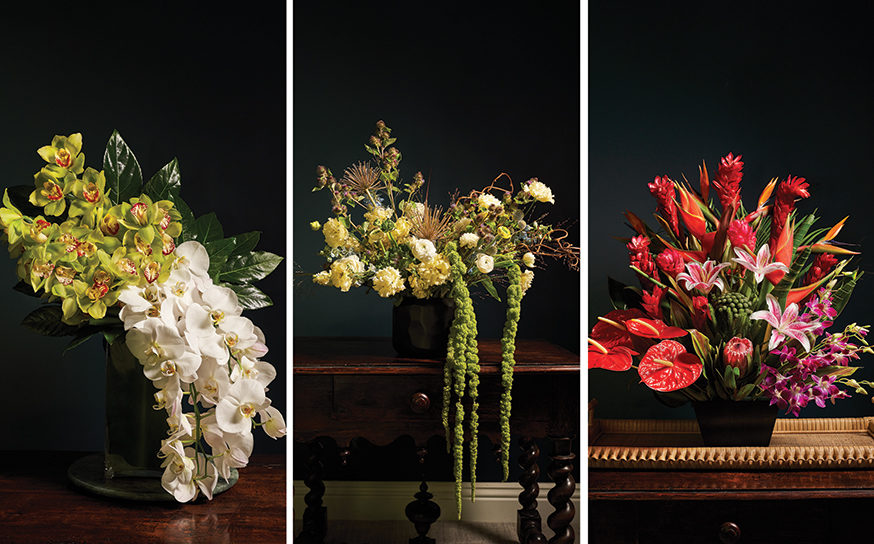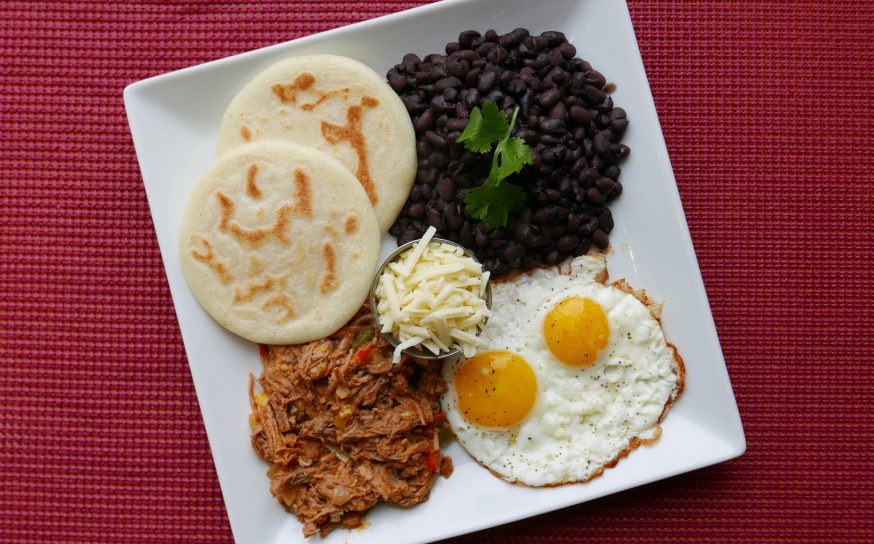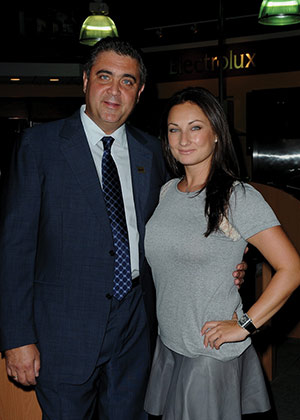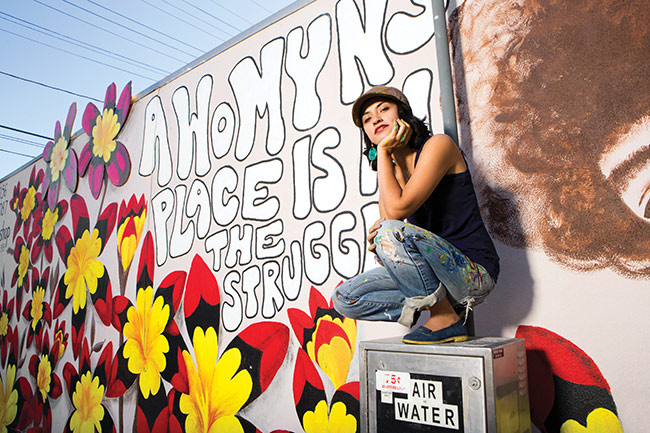
Color My World
A recently overturned LA ban on hand-painted murals is preserving a beautifcation effort aimed at one of the most blighted areas of the Valley. It’s also opening doors for a new wave of young artists focused on improving neighborhoods and boosting careers.
-
CategoryUncategorized
-
Written byPauline Adamek
Your murals are the best part of my daily drive to work, nothing but pure inspiration to conquer the day at hand. Thank you!” That’s just one of several effusive fan comments adorning the Facebook page of muralist Levi Ponce. A notation on a Facebook photo of one of Kristy Sandoval’s self-created murals sunnily proclaims, “With a paintbrush in my hand and an idealist’s mind, I will create a more colorful world!”
Both Kristy and Levi are part of a dedicated crew of young art enthusiasts who, for the past few years, have quietly and diligently been changing the face of their beloved Northeast Valley neighborhood. Infamous in the ‘70s for gang activity, today Pacoima—just east of the 5 and south of the 118 and 210 intersection—is a tight-knit community. The changes started during the ‘90s with some citizen-led concerted activism, done in conjunction with police, which began having an impact on crime.
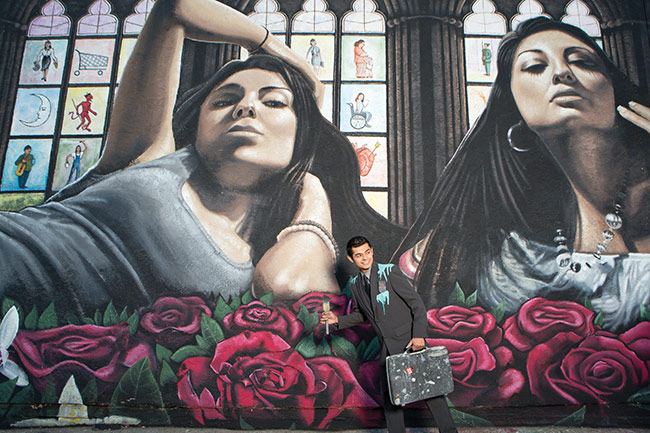
Levi Ponce with his larger-than-life creations.
Synergy also seems to be driving the latest round of community improvements—a team effort aimed at replacing graffiti-filled walls with colorful, glorious murals painted by accomplished, talented artists. Dozens have popped up on walls across the city, and more are in the works. Dubbed the Valley’s “Mural Mile” by KCET, close to 30 hand-painted murals can be spotted along a mile and a half of Van Nuys Boulevard, between Arleta and Norris Avenues.
Delighted by the murals in his ’hood, about 16 months ago local business owner Raphael Andrade of Myke’s Café decided the exterior wall of his newly opened restaurant needed a fresh face. He wanted something “bright and colorful that matched the theme of my café.”
Raphael asked around and kept hearing the name Kristy Sandoval. He contacted her and hired her, along with Ramiro “Rah” Hernandez, to create “Mi Vida, Mi Cultura.” Completed in July 2012, the vivid imagery was created as a collaborative design with El Nido Family Center’s Gang Reduction and Youth Development (GRYD) program, which provided materials and volunteers. Depicting happy children riding bikes and playing music, a boy clutching a book peels back the landscape to reveal icons of his cultural origins, representing the life and culture of youth today.
“That wall had been painted with gang markings and other stuff a couple of times. But since Kristy painted it, it hasn’t been touched by gangs or taggers. For graffiti artists, it is a matter of respecting someone they view as a fellow artist. I think everyone in this community—even the gang members—likes what artists like Kristy are doing here,” Raphael shares.
Kristy’s mural, as it turns out, sparked a formative collaboration. The newer work was obliterating an older one by well-known LA sign painter and artist Hector Ponce. (His murals include the five-story high James Olmos portrait near MacArthur Park). As a courtesy, she contacted Hector’s 26-year-old son Levi Ponce—another local muralist—to let him know.
Recalls Kristy, “I invited Levi out, and he helped us and we just got to know each other.” Kristy returned the favor, picking up brushes to assist Levi with his Mona Lisa project down the street. Entitled “Pacoima Art Revolution,” the 22’-by-24’ work depicts a Mona Lisa reimagined as a charro (a Mexican cowboy), clutching a sword and wearing a sombrero with a rifle slung across her back.
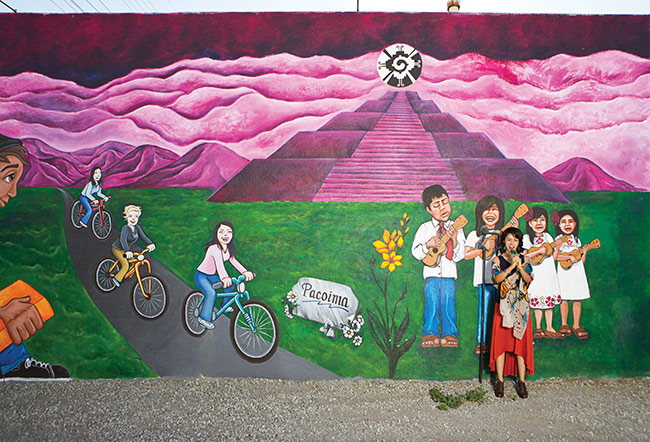
Kristy Sandoval with “Mi Vida, Mi Cultura”
Next Kristy painted a portrait of black activist Assata Shakur a few doors down on the side of owner Greg Faucett’s barbershop and beauty salon, Stylesville. Greg had seen the mural going up on Myke’s Café and got inspired to enhance his business of 56 years.
“I told her, ‘I don’t care what you paint, so long as the subject is black,’” explains the African-American barber. Kristy did some research and decided her subject would be the ‘70s Black Panther activist. The afro-adorned head and slender shoulders of freedom fighter Assata Shakur dominates one side of the mural, with her clarion call, “A womyn’s place is in the struggle,” and “It is our duty to fight for our freedom… We have nothing to lose but our chains,” written large and festooned with colorful corn lilies.
Explains the 31-year-old muralist, “Assata stood up for what she believed in and is an inspiration as a strong woman of color who didn’t back down. What makes this mural special to me is that it was painted by an all-woman crew.” Marvels Greg, “I didn’t expect it to be so powerful.”
While creating the pro-feminist mural, Kristy embarked on a new partnership with other women artists in the area. Adopting the moniker H.O.O.D Sisters (“It stands for ‘Honoring Ourselves, our Origins and our Dreams,’” Kristy explains), this collective of eight or so female muralists, plus their volunteer crew of more than 20, meets once a month to discuss available walls, plan designs and other community matters.
“It was an evolution—I wasn’t born a muralist right away!” laughs Levi Ponce. “My dad’s a sign painter for a living; he’s been doing it for 50 years. Growing up, I would go to work with him, ever since I was potty-trained, actually. My Mom said, ‘I got him Monday through Friday—you got him on the weekends!’ He would have me do basic stuff like ‘Paint this post white.’”
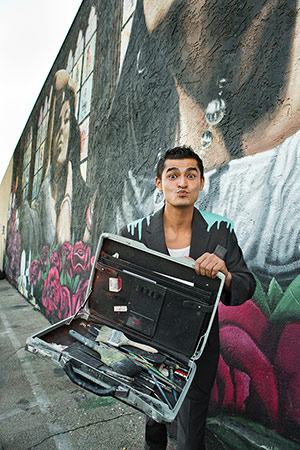
Levi helped his father for years, and by the time he was in high school he had progressed to more advanced illustration. “My dad wasn’t paying me much—I think I got $5 a day, which is less than $1 an hour! We worked long days.”
Levi says he “got smart” and started doing some of his father’s smaller gigs. “He wouldn’t take a $50 job, so I would take the client.” By the age of 15, Levi had his own clients. “That got me through college,” he recalls.
Levi studied animation at California State University Northridge, earning a BA degree. Now 26, by day he works as a digital and visual effects artist for New Deal Studios. The muralist returned to sign painting after post-college film work dried up. Then came his genius idea for self-promotion.
Levi Ponce, who works by day job as a special effects artist for a production company.
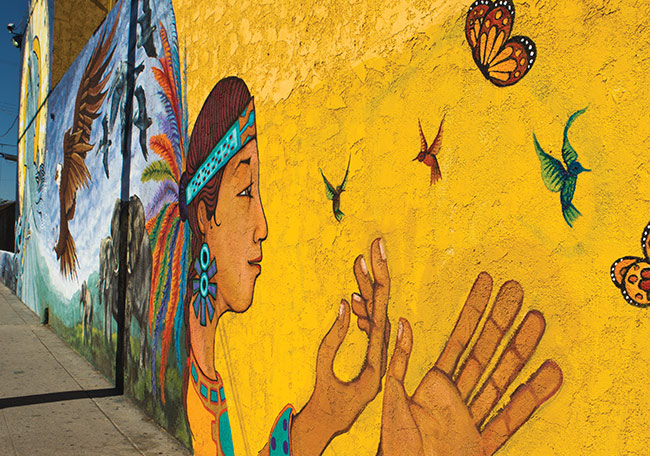
A striking portrait by Levi
“I thought, ‘What better way to advertise yourself than to paint a big mural?’” Applying his bold style on a large scale, he painted actor Danny Trejo in 2011. “From day one, the experience was unforgettable. It immediately changed from potential profit to ‘I need to do this again!’”
Many of the murals Levi designs and paints are self-funded. He makes it work by getting local business and property owners to provide a blank canvas and then transforms it into a community project by enlisting local kids as volunteers.
Levi has even made friends with local graffiti crews—typically, taggers are a muralist’s arch-enemies—including one group led by an artist known as Mute. Levi’s works range from an ethnic take on classical works, such as those by Michelangelo, da Vinci and Vermeer (“The Girl with the Hoop Earring” at 14001 Van Nuys Boulevard), to authentic representations of his Latin culture and tributes to local figures such as actors James Olmos and Cheech Marin.
As for the challenges of working on a scale that’s larger than life, Levi laughs, “It’s all about mathematical calculations and ratios. To me it’s no different than painting something the size of a postcard; I just make it bigger.”
“La Lady Liberty” was painted in 2013 using brushes and acrylic paint. The 70’-wide-by-22’-high mural of a Latin-looking, noble profile, a spiky crown atop her swirling hair, is a massive collaboration with a team of local graffiti artists and muralists, plus a host of volunteers—all name-checked in one corner of the grand-scaled artwork. The mural continues around the corner of Bradley Street with Kristy’s “Decolonized,” which she painted with help from her posse.
She says, “This image is representative of the newly educated generation that is making things happen in Pacoima, more specifically the female energy of the community.” The figure is shown releasing birds and monarch butterflies, “symbolizing the freedom of migration amongst animals, as it should also be for humans as well.” The artist further explains her symbolism: “The tattoo on her arm is Coyolxauhqui, the Aztec moon goddess, and the flowers are California poppies.”
Levi recently partnered with an organization called 11:11 Creative Collective. “They find the walls, get contracts signed, and then I come in and do the artwork. We’ve got four walls lined up right now,” he beams, including one in Canoga Park.
Meanwhile, Kristy is also getting some career traction. “Since the ban was overturned, I’ve gotten three paid jobs—all from people who have seen my murals here in Pacoima.” She also just commenced work as a teaching artist for her artist-in-residency with Urban Arts Partnership at the Arts Theater Entertainment School at Cesar Chavez Learning Academies, integrating art into a ninth-grade math and English class.
The muralists are thrilled the ban on murals on privately owned buildings in LA has been lifted. It not only makes them “street legal,” but at least for Levi, the ruling is helping him accomplish yet another goal: “We’re the entertainment capital of the world—we have the world’s best artists here. I want us all to bring public art back to LA.”





